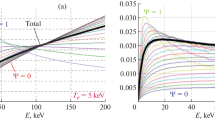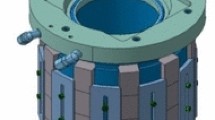Abstract
Ongoing research and development efforts are being conducted at Sungkyunkwan University—Korea with the objective of creating an Atomic Mass Spectrometer (AMS) cyclotron that presents a more compact and cost-effective alternative to the conventional Tandem AMS system. The construction of cyclotrons frequently encounters difficulties, mostly arising from instabilities and substantial losses of ion beams, particularly during the injection phase that usually depends on an axial injection mechanism. In this paper, we undertake an in-depth investigation into the comprehensive design exploration of a low-energy carbon ion beam line. The optimization processes were done using Trace3D, TOSCA, and OpticExpert codes. The TOSCA software, in particular, enabled the use of three-dimensional simulations related to the complicated behavior of ion beams. The presented paper offers an in-depth examination of the beam line, illustrating the engineering elements of essential optical parts, such as quadrupoles and dipoles. Following the production process, all of the beam line parts were subjected to extensive testing. The final results, including magnetic field measurements and field gradients, showed an excellent match with our physical models. At the same time, a thermal study of the air-cooled quadrupole coils was carried out using the ANSYS APDL program. The construction of beam line has been done. An analysis of beam measurements will be carried out and subsequently compared to the calculated models. The objective of this comparison analysis is to ascertain the most optimal design method, with a focus on achieving efficiency and reliability in the final beam line system.













Similar content being viewed by others
References
Libby, W.F. (1960). Nobel Prize in Chemistry. NobelPrize.org.
C. Tuniz, J.R. Bird, D. Fink, G.F. Herzog, Accelerator mass spectrometry: Ultrasensitive analysis for global science (CRC Press, 1998)
M.L. Roberts, J.R. Southon, J.S. Vogel, The “Cyclotrino”: a dedicated cyclotron for accelerator mass spectrometry. Nucl. Instrum. Methods Phys. Res., Sect. B 52(3–4), 437–440 (1990)
K. Li, M. He, J. Liu, Enhancements in the transmission efficiency of the Shanghai Mini Cyclotron AMS. J. Mass Spectrom. Accel. Tech. 21(2), 115–120 (2003)
D.G. Kim, J.Y. Kim, H.C. Bhang, Study on the injection system for cyclotron mass spectrometry. J. Korean Phys. Soc. 59(2), 2018–2021 (2011)
H. Namgoong et al., Design of cyclotron magnet with tenth harmonics for accelerator mass spectrometry. J. Korean Phys. Soc. 82, 147–153 (2022)
H.J. Liebl, R.F.K. Herzog, Sputtering ion source for solids. J. Appl. Phys. 34(9), 2893–2896 (1963)
https://www.pelletron.com/wp-content/uploads/2017/02/SNICS-v2.pdf. Accessed 2 Sept 2019.
CST Studio Suite. [Computer software]. Dassault Systèmes (2022).
Rusthoi, D.P., & Lysenko, W.P. Further improvements in TRACE 3-D. In Proceedings of PAC 97. Los Alamos National Laboratory, Los Alamos (1997).
https://github.com/garamhahn/OpticsExpert. Accessed 2 Sept 2019.
W.C. Alexander, Maury tigner handbook of accelerator physics and engineering (World Scientific Publishing Co. Pte. Ltd, 1999)
J.J. Livingood, The optics of dipole magnets (Academic Press, Cham, 1969), p.63
OPERA TOSCA. [Computer software]. Cobham Technical Services (2020)
Acknowledgements
This paper was supported by Radiation Technology R&D program through the National Research Foundation of Korea funded by the Ministry of Science, ICT & Future Planning. [2017M2A2A4A02020347, Development of an Accelerator Mass Spectrometer based on Artificial Intelligence]. This work was supported by the Korea Medical Device Development Fund grant funded by the Korea government (the Ministry of Science and ICT) (Project Number: 1711135001, KMDF_PR_20200901_0042). The authors wish to express their gratitude to Dr. K.H. Park from Pohang Accelerator Laboratory for their valuable assistance throughout the editorial phase of this paper. Additionally, the authors would like to acknowledge Dr. H. Garam from Pohang Accelerator Laboratory, who is the developer of the OpticsExpert software, for his significant advice and support.
Author information
Authors and Affiliations
Corresponding author
Additional information
Publisher's Note
Springer Nature remains neutral with regard to jurisdictional claims in published maps and institutional affiliations.
Rights and permissions
Springer Nature or its licensor (e.g. a society or other partner) holds exclusive rights to this article under a publishing agreement with the author(s) or other rightsholder(s); author self-archiving of the accepted manuscript version of this article is solely governed by the terms of such publishing agreement and applicable law.
About this article
Cite this article
Gad, K.M.M., Namgoong, H., Ghergherehchi, M. et al. Technical design of an axial injection low-energy carbon beam line. J. Korean Phys. Soc. 84, 681–693 (2024). https://doi.org/10.1007/s40042-024-01042-6
Received:
Revised:
Accepted:
Published:
Issue Date:
DOI: https://doi.org/10.1007/s40042-024-01042-6




